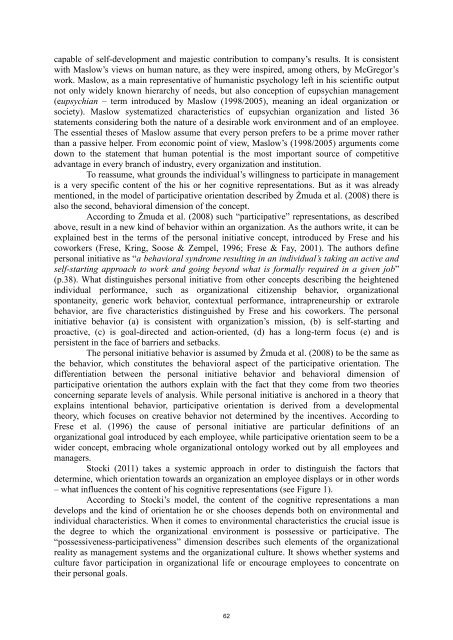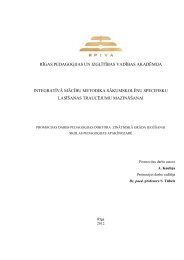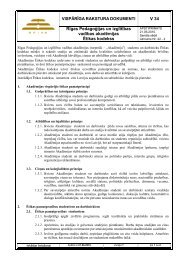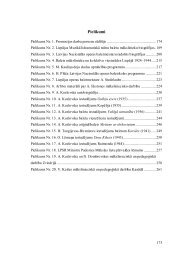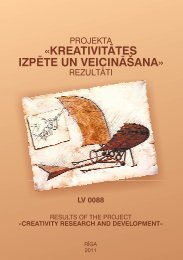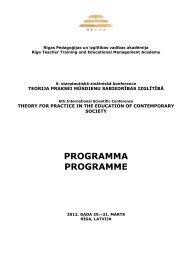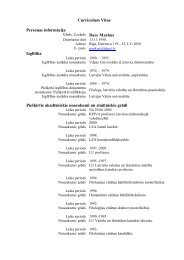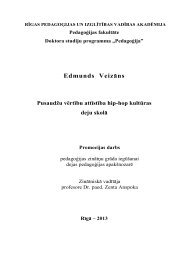saturs - rpiva
saturs - rpiva
saturs - rpiva
- No tags were found...
Create successful ePaper yourself
Turn your PDF publications into a flip-book with our unique Google optimized e-Paper software.
capable of self-development and majestic contribution to company’s results. It is consistent<br />
with Maslow’s views on human nature, as they were inspired, among others, by McGregor’s<br />
work. Maslow, as a main representative of humanistic psychology left in his scientific output<br />
not only widely known hierarchy of needs, but also conception of eupsychian management<br />
(eupsychian – term introduced by Maslow (1998/2005), meaning an ideal organization or<br />
society). Maslow systematized characteristics of eupsychian organization and listed 36<br />
statements considering both the nature of a desirable work environment and of an employee.<br />
The essential theses of Maslow assume that every person prefers to be a prime mover rather<br />
than a passive helper. From economic point of view, Maslow’s (1998/2005) arguments come<br />
down to the statement that human potential is the most important source of competitive<br />
advantage in every branch of industry, every organization and institution.<br />
To reassume, what grounds the individual’s willingness to participate in management<br />
is a very specific content of the his or her cognitive representations. But as it was already<br />
mentioned, in the model of participative orientation described by Żmuda et al. (2008) there is<br />
also the second, behavioral dimension of the concept.<br />
According to Żmuda et al. (2008) such “participative” representations, as described<br />
above, result in a new kind of behavior within an organization. As the authors write, it can be<br />
explained best in the terms of the personal initiative concept, introduced by Frese and his<br />
coworkers (Frese, Kring, Soose & Zempel, 1996; Frese & Fay, 2001). The authors define<br />
personal initiative as “a behavioral syndrome resulting in an individual’s taking an active and<br />
self-starting approach to work and going beyond what is formally required in a given job”<br />
(p.38). What distinguishes personal initiative from other concepts describing the heightened<br />
individual performance, such as organizational citizenship behavior, organizational<br />
spontaneity, generic work behavior, contextual performance, intrapreneurship or extrarole<br />
behavior, are five characteristics distinguished by Frese and his coworkers. The personal<br />
initiative behavior (a) is consistent with organization’s mission, (b) is self-starting and<br />
proactive, (c) is goal-directed and action-oriented, (d) has a long-term focus (e) and is<br />
persistent in the face of barriers and setbacks.<br />
The personal initiative behavior is assumed by Żmuda et al. (2008) to be the same as<br />
the behavior, which constitutes the behavioral aspect of the participative orientation. The<br />
differentiation between the personal initiative behavior and behavioral dimension of<br />
participative orientation the authors explain with the fact that they come from two theories<br />
concerning separate levels of analysis. While personal initiative is anchored in a theory that<br />
explains intentional behavior, participative orientation is derived from a developmental<br />
theory, which focuses on creative behavior not determined by the incentives. According to<br />
Frese et al. (1996) the cause of personal initiative are particular definitions of an<br />
organizational goal introduced by each employee, while participative orientation seem to be a<br />
wider concept, embracing whole organizational ontology worked out by all employees and<br />
managers.<br />
Stocki (2011) takes a systemic approach in order to distinguish the factors that<br />
determine, which orientation towards an organization an employee displays or in other words<br />
– what influences the content of his cognitive representations (see Figure 1).<br />
According to Stocki’s model, the content of the cognitive representations a man<br />
develops and the kind of orientation he or she chooses depends both on environmental and<br />
individual characteristics. When it comes to environmental characteristics the crucial issue is<br />
the degree to which the organizational environment is possessive or participative. The<br />
“possessiveness-participativeness” dimension describes such elements of the organizational<br />
reality as management systems and the organizational culture. It shows whether systems and<br />
culture favor participation in organizational life or encourage employees to concentrate on<br />
their personal goals.<br />
62


